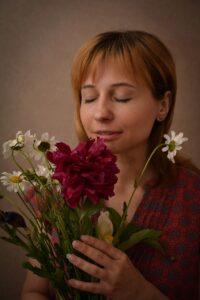
The Olfactory Nerve and Mood
We are instructed to use all five senses when writing descriptions. I must admit I often forget to use the sense of smell.
We smell with the olfactory nerve, the first cranial nerve. Cranial nerves are paired nerves that connect to the back or bottom of the brain, exit the cranium (skull and facial bones), and help us taste, smell, hear, feel sensations, and move our facial muscles and tongue. The olfactory nerve is also involved in autonomic function (automatic function) – affecting salivation, gastrointestinal function, appetite, nausea, interest or lack of interest, and sexual arousal.
Much of our sense of taste is actually from smell and the olfactory nerve.
The olfactory nerve endings are in the upper nasal cavity, near the opening to the frontal sinuses. The nerves connect to the bottom of the frontal lobe. And, because the olfactory nerve tract is connected to the limbic system, it affects emotions and memory, and thus mood.

That’s why a smell can quickly set off a memory or mood, and use of smell/scent in our descriptions may help to establish mood in our stories, ex. smell of our favorite meal, our old baseball mitt from Little League, corsage flower from prom, the scent of a tree that bloomed in our backyard, or the scent of our favorite cologne/perfume, etc.
Thus, olfactory nerve function—smell/scent—may help establish emotion and mood in our stories. But, how exactly does that happen? The bottom line is that we don’t really know. Here are a couple paragraphs from an article in GoodTherapy in 2019.
“The brain makes new neurons from stem cells in the hippocampus (part of the limbic system), suggesting the hippocampus and the feelings and memories it supports can change with new experiences…
“The limbic system is dynamic, changing with input from a person’s environment. Experience changes this important brain region, and that may help explain why people’s psychological and physiological experiences change over time…”
Though it may be fuzzy logic we’re using here (fuzzy can be good in fiction), let’s train our backsides, each time we sit in our writing chairs, to send our brains a memo to spray some smells/scents into our descriptions and plot.
Questions:
- What examples have your read or written with smell/scent as source of mood?
- What is your favorite scent/smell? What smell do you hate?
- What smells/scents (in your opinion) are most powerful for creating mood?
- Bonus points: What are the two most powerful smells on Mackinac Island?
